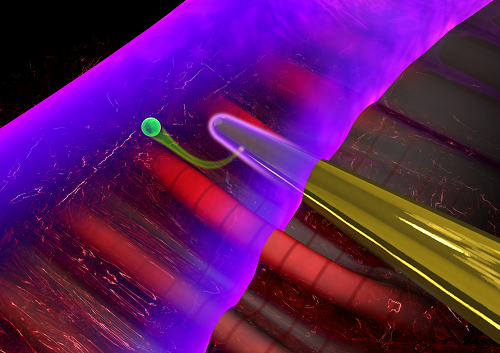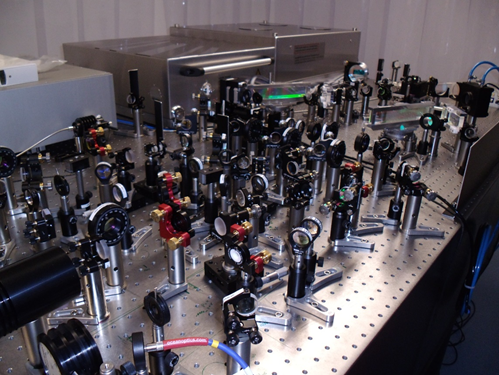What happens to molecules that are adsorbed on the surface of a nanoparticle when a very intense but short, laser electric field impinges on the complex? This is a question of profound and actual importance in the fields of nanosciences and nanotechnology. We have recently developed a spectroscopic framework to study and understand the dissociation of organic molecules on nanoparticles caused by the locally enhanced electric field from few-cycle intense laser pulses. The nanoscope is an instrumental development where individual particles are entered from atmospheric pressure into the ion source of a mass spectrometer held in an ultrahigh vacuum. Molecules such as water or ethanol, or others, adsorbed on the surface are then dissociated and ionized on individual particles by the laser pulse and the mass and abundance of the fragments are determined, shedding light on different possible channels of dissociation. To reveal where on the surface of the individual particles these reactions take place with nanometric precision, at the fs and sub fs time scale, we numerically reconstruct the classical trajectories of the ions hitting the spatially resolved detector to successfully backtrack the place of their formation. With this new technique, we aim to clarify basic aspects of the catalytic properties of different types of nanoparticles, an achievement of potential great future impact.
Selected recent publications:
P. Rosenberger et al., ACS Phot. 7, 1885 (2020)
P. Rupp et al., Nat. Com. 10, 4655 (2019)


The interaction of light with nanostructures exhibits two remarkabale features. The incident electromagnetic field can be enhanced by up to several orders of magnitude. Furthermore, these enhanced near-fields are confined to and vary on a scale of a few nanometers around the nanostructure, well below the diffraction limit of the exciting light. These effects form the basis for applications of nanostructures in science and technology. We aim at combining the spatial resolution provided by nanostructures with the temporal resolution offered by the short pulse laser sources in our laboratory, reaching into the attosecond domain. We study strong-field interactions with nanostructures and nanodevices, which exhibit many interesting differences to well-known strong-field atomic physics. We study the dynamics of light-generated electrons to unravel the effects of light-electron and collective charge interactions. Attosecond streaking, a pump-probe technique with synchronized attosecond extreme ultraviolet pulses and optical laser pulses, is one of the powerful techniques we employ to reconstruct nanolocalized electric fields and electron dynamics with attosecond temporal and nanometer spatial resolution. This ability will be instrumental in developing ultrafast plasmonic circuitry, which can overcome current limitations in resistive electronics and might open an avenue towards quantum computing at ambient temperature.
Selected recent publications:
J. Schötz et al., ACS Photonics 6, 357 (2019)
L. Seiffert et al., Nat. Phys. 13, 766 (2017)
Strong laser fields and attosecond pulses can be employed to manipulate and observe molecular processes. The control of reactions with intense laser fields offers manipulation of strongly-coupled nuclear and electronic motion, which opens new photon-based reaction pathways. Tailoring the electric-field waveform of optical pulses on sub-cycle timescales opens the door to the control of electron and nuclear dynamics in molecules. In this project we use 3D-momentum imaging techniques such as velocity-map imaging (VMI) and reaction microscopy (REMI) to investigate the sub-cycle control of strong-field processes in molecules of increasing complexity. In close collaboration with theory we gain deep insight into the related coherent electron and nuclear dynamics.
Selected recent publications:
C. Burger et al., Struct. Dyn. 5, 044302 (2018)
H. Li et al., Opt. Exp. 25, 14192 (2017)
I. Yavuz et al., Phys. Rev. A 93, 033404 (2016)
M. Kübel et al., Phys. Rev. Lett. 116, 193001 (2016)
H. Li et al., Struct. Dyn. 3, 043206 (2016)


Within this new project we currently develop the infrastructure to perform ultrafast microscopy on nanostructures for nanoelectronics and medical applications. Both applications are based on a novel passively carrier-envelope phase (CEP) stable laser system, that is based on optical-parametric-chirped-pulse-amplification (OPCPA) and can operate at high repetition rates. We currently obtain CEP-stable few-cycle pulses close to 2 µm with pulse energies in the hundred µJ range at 0.1 MHz, which are applied in photoemission experiments on nanostructures. We aim to employ our femtosecond OPCPA laser system in non-linear microscopy studies, where the relatively high pulse energy permits pulse shaping with full amplitude and phase control, counteracting dispersion of the microscope objective, and employ rapid pump-probe schemes. We aim to develop and explore ultrafast nanodevices using this platform, and to explore the system in non-linear, multi-modal microscopy on tissue samples. In biological applications, we can also counteract dispersion of organic matter for deep-tissue imaging. Ultrashort pulses are highly beneficial in terms of reduced cell damage and also provide the required increased contrast for label-free imaging. Multi-modal, non-invasive imaging, as explored in this project, aims at cancer cell molecular analysis enabling targeting cancer down to the single cellular level.
Selected recent publications:
M. Neuhaus et al., Opt. Exp. 26, 16074 (2018)
J. Schötz et al., Phys. Rev. A 97, 013413 (2018)
P. Wnuk et al., Opt. Exp. 24, 18551 (2016)




